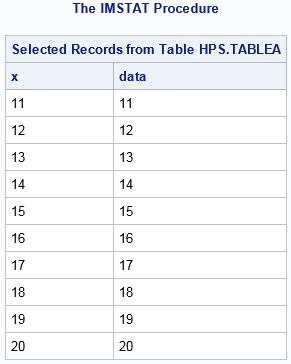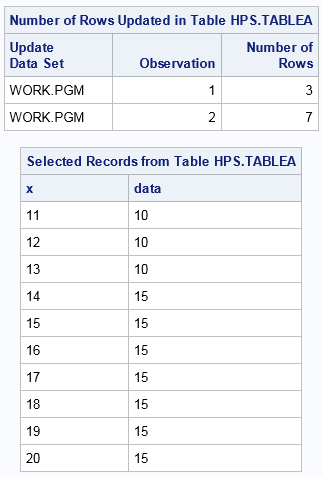IMSTAT Procedure (Data and Server Management)
- Syntax
 Procedure SyntaxPROC IMSTAT (Data and Server Management) StatementBALANCE StatementCOLUMNINFO StatementCOMPRESS StatementCOMPUTE StatementCREATETABLE StatementDELETEROWS StatementDISTRIBUTIONINFO StatementDROPCOLUMN StatementDROPTABLE StatementFETCH StatementFREE StatementLIFETIME StatementNUMROWS StatementPARTITION StatementPARTITIONINFO StatementPROMOTE StatementPURGETEMPTABLES StatementREPLAY StatementSAVE StatementSCHEMA StatementSCORE StatementSERVERINFO StatementSERVERPARM StatementSERVERTERM StatementSERVERWAIT StatementSET StatementSTORE StatementTABLE StatementTABLEINFO StatementUNCOMPRESS StatementUPDATE StatementQUIT Statement
Procedure SyntaxPROC IMSTAT (Data and Server Management) StatementBALANCE StatementCOLUMNINFO StatementCOMPRESS StatementCOMPUTE StatementCREATETABLE StatementDELETEROWS StatementDISTRIBUTIONINFO StatementDROPCOLUMN StatementDROPTABLE StatementFETCH StatementFREE StatementLIFETIME StatementNUMROWS StatementPARTITION StatementPARTITIONINFO StatementPROMOTE StatementPURGETEMPTABLES StatementREPLAY StatementSAVE StatementSCHEMA StatementSCORE StatementSERVERINFO StatementSERVERPARM StatementSERVERTERM StatementSERVERWAIT StatementSET StatementSTORE StatementTABLE StatementTABLEINFO StatementUNCOMPRESS StatementUPDATE StatementQUIT Statement - Overview
- Concepts
- Examples

UPDATE Statement
The UPDATE statement performs rowwise updates of the data in an in-memory table.
Syntax
Required Arguments
variable
specifies the name of the variable to update.
value
specifies the value to assign to the variable.
DATA=libref.member-name
specifies the libref
and table name of a SAS data set to use for updating the in-memory
table. The data set must contain the variables and values that you
want to update. You can specify a _WHERE_ variable
in the data set to apply as a filter to the particular set of update
values. This clause in the data set augments the overall WHERE clause,
if one is specified.
UPDATE Statement Options
CODE=file-reference
specifies a file reference to a SAS program to use for the row update (an update script). You can combine the specification of a SAS program through the CODE= option with the name-value pair specification or the DATA= specification for bulk updates. The updates that are specified in the name-value pair and DATE= specifications are performed first and then the update script executes on the modified row to produce the update.
| Alias | PGM= |
NOPREPARSE
prevents the procedure from pre-parsing and pre-generating code for temporary expressions, scoring programs, and other user-written SAS statements.
| Alias | NOPREP |
SAVE=table-name
saves the result table so that you can use it in other IMSTAT procedure statements like STORE, REPLAY, and FREE. The value for table-name must be unique within the scope of the procedure execution. The name of a table that has been freed with the FREE statement can be used again in subsequent SAVE= options.
TEMPEXPRESS="SAS-expressions"
TEMPEXPRESS=file-reference
specifies either a quoted string that contains the SAS expression that defines the temporary variables or a file reference to an external file with the SAS statements.
| Alias | TE= |
TEMPNAMES=variable-name
TEMPNAMES=(variable-list)
specifies the list of temporary variables for the request. Each temporary variable must be defined through SAS statements that you supply with the TEMPEXPRESS= option.
| Alias | TN= |
Details
Usage Notes
ODS Table Names
|
ODS Table Name
|
Description
|
Option
|
|---|---|---|
|
RowUpdate
|
Number of Rows Considered
for an Update
|
Default
|
Examples
Example 1: Update with a SAS Program
libname example sasiola host="grid001.example.com" port=10010 tag=hps;
data example.prdsale;
set sashelp.prdsale;
run;
filename pgm "some-path/update.pgm"; 1
data _null_;
file pgm;
put "if quarter=3 and product eq 'SOFA' then do;";
put " predict = 1.05 * predict;";
put "end;";
put "if quarter=3 and product ne 'SOFA' then do;";
put " predict = 1.03 * predict;";
put "end;";
run;
proc imstat data=example.prdsale; 2
/* columninfo; */
/* fetch / format; */
update / code=pgm;
run;
where quarter=3;
fetch / format;
quit;| 1 | The FILENAME statement and the DATA statement are used to write a simple SAS program to a file. The file reference, Pgm, is used later in the UPDATE statement. |
| 2 | In the PROC IMSTAT example, the COLUMNINFO and FETCH statements are enclosed in comments, but they are helpful for helping you understand the data. The UPDATE statement uses the CODE= option to specify the file reference. The WHERE statement and FETCH statements are used to display the first 20 rows that were updated. |
Example 2: Update with a Data Set
libname example sasiola host="grid001.example.com" port=10010 tag=hps; data example.tableA; 1 do x=11 to 20; data = x; output; end; run; data pgm; 2 length _where_ $64; _where_ = "x between 5 and 13"; data = 10; output; _where_ = "x between 14 and 30"; data = 15; output; run; proc imstat data=example.tableA; fetch / format; run; quit; proc imstat data=lasr.tableA; update data=pgm; 3 run; fetch / format orderby=(x); quit;
| 1 | The SAS LASR Analytic Server engine and a DATA step are used to create a simple in-memory table with columns named x and Data. |
| 2 | A data set, named Pgm, is created in the Work library. The data set describes two updates to make an in-memory table. The _WHERE_ column is used to specify the rows to modify. |
| 3 | The DATA= option is used to specify the data set with the update instructions. |

